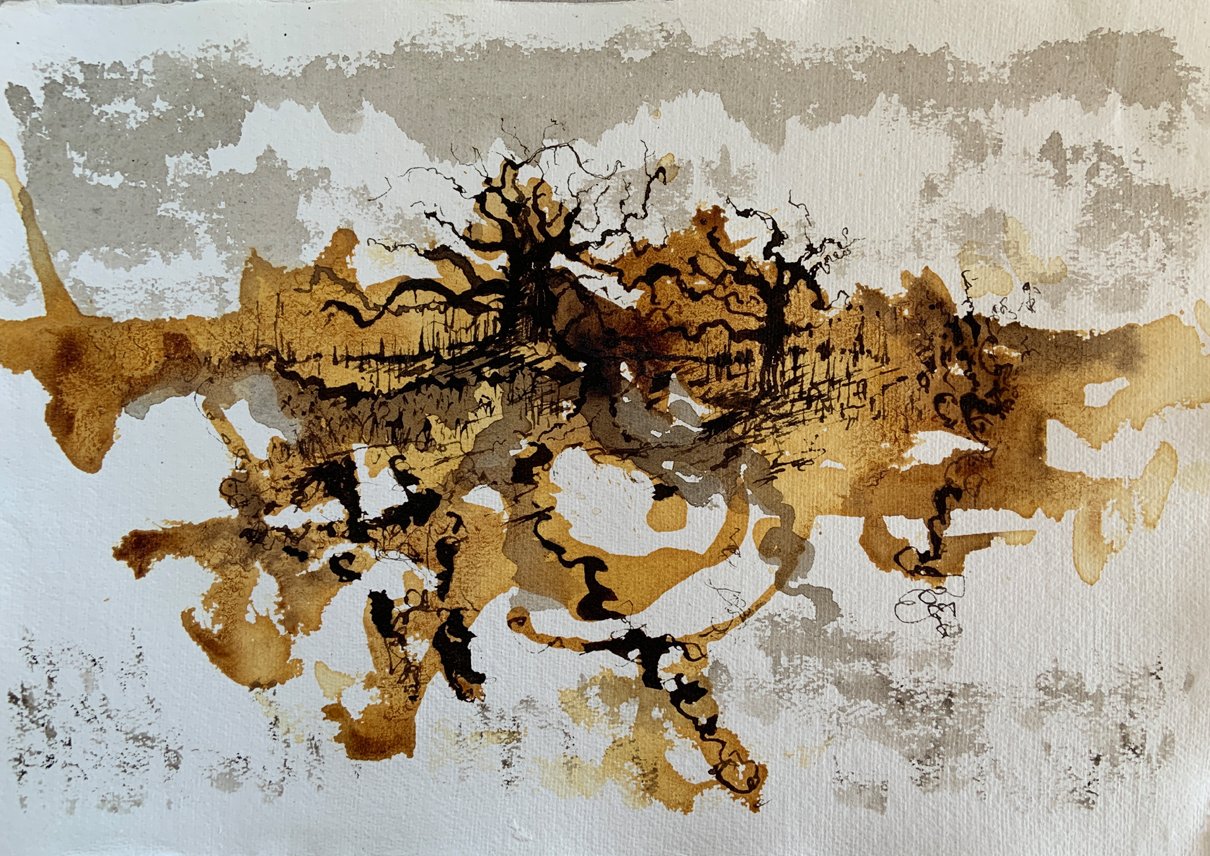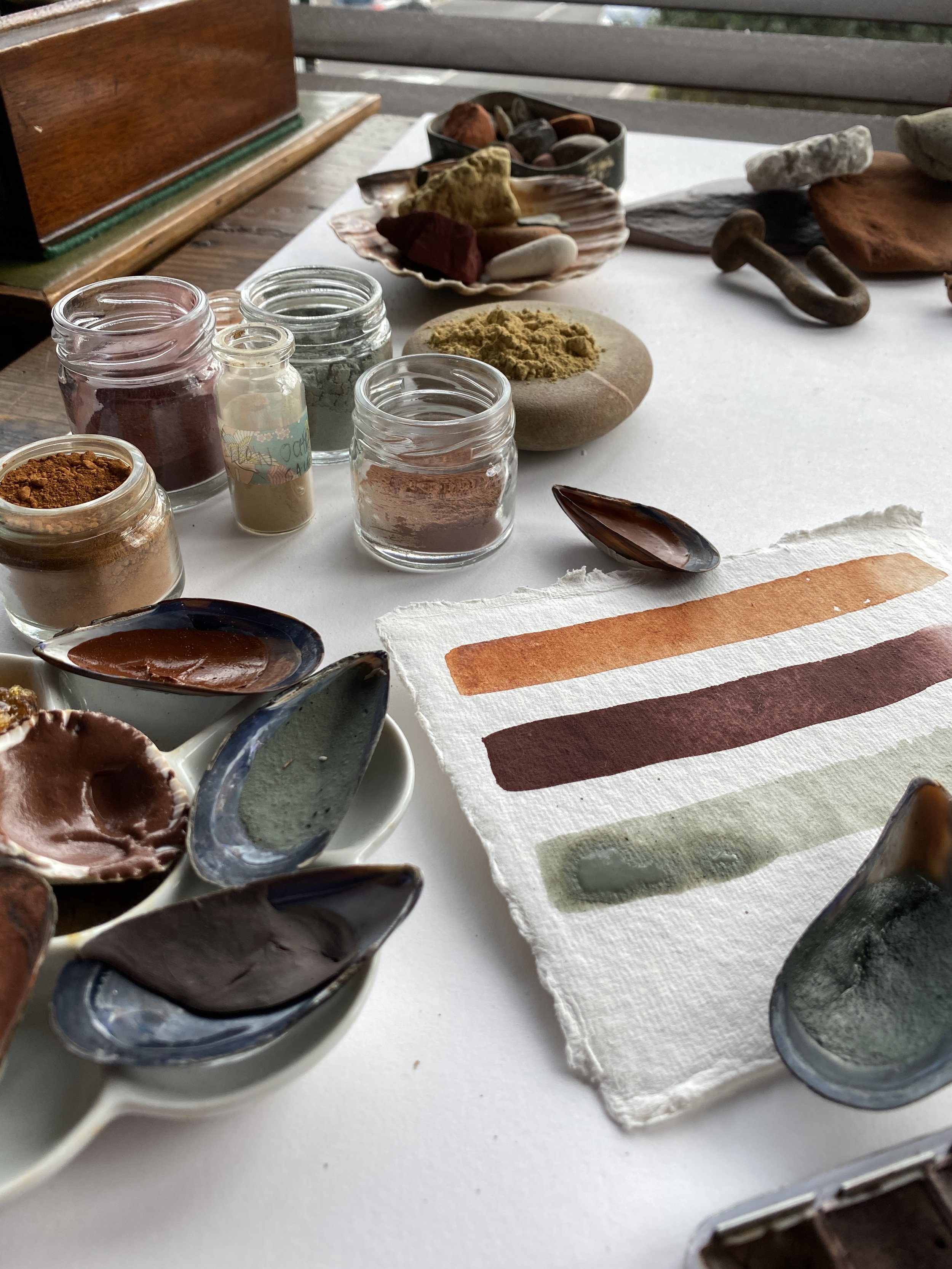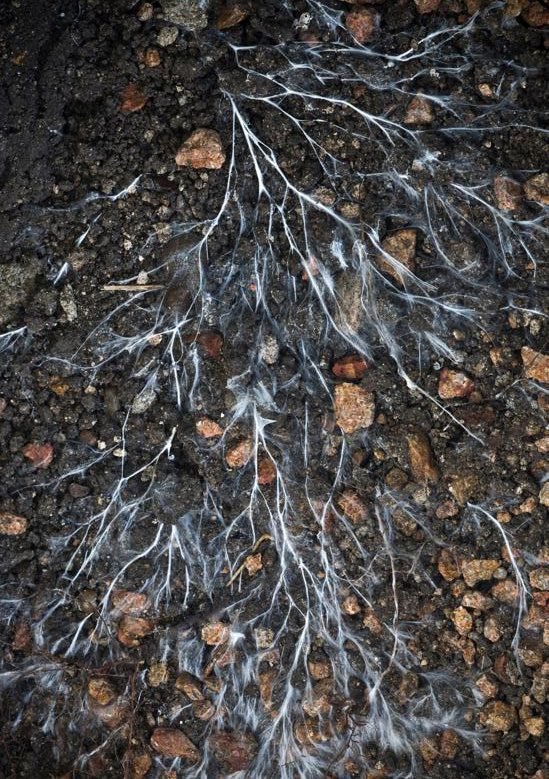
Where many rivers meet
by Victoria Thomas
In speaking with Caroline Ross @foundandground, artist, author, teacher, scavenger, Dorset woman, and all-around Taoist wild child from her home in Bournemouth, UK, she chuckles and says she’s afraid that she sounds posh. As a matter of fact, she doesn’t, although her accent is BBC-perfect. Perhaps the salt air and gull cries have nibbled away at any whiff of artifice. Today, Ross devotes much of her time to paint-making from foraged natural pigments and art materials that range from powdered minerals to vitreous humor (eyeball-juice from the eyes of deer) to oak galls and berry stains to cuttlefish ink culled from a beached cuttlebone.
Her book, Found and Ground - A Practical Guide to Making Your Own Natural Paints, will be published by Search Press in June 2023.
Meanwhile, she writes on the Tao, the embodied life, and the making of earth-friendly art at “Uncivil Savant,”, carolineross.substack.com. “Nature is not a resource to be exploited by us,” she explains. “We are part of it. We are embedded in it, embedded in the mess of it. It’s not something out there. It is who and what we are, rather than something we go to visit.”
She regards her former lives, as the founder of a Tai Chi school, a Tai Chi teacher, a singer, and a painter of “mostly bad” paintings, with self-compassion and humor, and seemingly no regret. As a member of the Dark Mountain Project and the Wilderness Art Collective, her subject-matter is the need to undo our civilization and re-wild ourselves. Her teachings include participation in the workshops “When the Mountain Speaks with Us” with the Dark Mountain Collective, and “Wild Twins” with Dark Mountain Project co-founder, writer Paul Kingsnorth. “I don’t believe that we are doomed, by the way,” she says, alluding to the famously grim planetary conclusions of the Dark Mountain Manifesto.
Ross describes herself as an exile, and recounts the devastating house fire that jettisoned her from a beloved life as a river-dweller on Father Thames, a disaster accompanied by divorce and other casualties. But, she says matter-of-factly (after all, she’s English), “This exile has set me free.” These days, she lives in a little flat where half of her bedroom is occupied by art supplies, including the opalescent mussel shells she collects from the nearby beachfront to use as an aquatic mobile paintbox. Roving around her seaside community, she gathers and barters for rose-hips, chestnuts, acorns, pebbles, a fox-gnawed beef shin bone, clay, ochre, sparkly chips of mica, whatever a daily walk has to offer. Intended for use on paper, textile, handmade deerskin parchment and buckskin, her ground pigments are mixed with a medium called glair (made with egg-white), tempera (from egg-yolk), and cherry tree gum, gum exuded from plums (“plum gum”), and she’s currently developing some vegan, non-soy binding agents as alternatives to animal-sourced ingredients.



Her losses literally demonstrate “undoing,” as in moving away from the life manufactured by industry and capitalism. Her personal undoing in the form of the violent removal of a way of life that she loved, created new spaces in time, leaving nothing of her previous world but ashes. Understanding these losses as spaces and opportunities, she says, is what keeps Ross fully, keenly awake and alive.
In her substack, she recounts the classic Taoist story of “The Cook and the Cleaver,” a telling of how the Way precedes technique. The cook’s cleaver remains razor-sharp even after 19 years of constant use because he doesn’t use the cleaver to hammer away and hack at bone and gristle. Doing this -- and metaphorically, this is what most of us do with our lives -- makes the cleaver feel so exhaustingly heavy, and dulls the edge. Instead, the Taoist cook lands the blade in the slender space between the joints of the carcass, thus keeping the implement exquisitely fine and sharp. This tale also describes what Ross has managed to negotiate: she’s the cleaver, and her unlikely life today is the precious, often forgotten space between the bones.
The immediacy of her paintings challenges our usual quest for the Sublime, which often leads to a fiendish worship of technique. A flawless and cynical Rudolf Nureyev remarked that, “…technique is what you fall back on when you run out of ideas.” And so it is. We gasp at miniatures painted with a brush no thicker than an eyelash. We hold our breath in the workshop where the court’s velvets have been woven for five centuries, where one miscalculation, one errant flick of the wrist on the loom can demolish a fortune in weaving. We take ghastly delight in the idea of a forbidden embroidery stitch, the fine work accompanied by the warning that the price of mastering the stitch was blindness. But secretly we admit to ourselves that, although the precision and perfection of the finished product are impressive, something’s missing. The perfection feels flat and sterile. And so the pendulum swings. Bored with translucent porcelain teacups as achingly delicate as a dragonfly’s wing, we suddenly crave the comforting, rough clay and honesty, humility, and heft of a wabi-sabi mug.

Hunting for the Sublime is often like listening to a tenor who’s just polished off a ten-course meal. Sweat beads on his brow. His face reddens. The buttons of his waistcoat strain. Veins pop out on his neck, his throat, that conduit of his genius. As his voice ascends, we cross our fingers, close our eyes, and hope for the best -- or perhaps the worst. Luciano Pavarotti famously remarked that his audiences were secretly waiting for him to explode onstage “come un palloncino” -- like a balloon, or like a winged mythic figure who flies too close to the sun, driven higher and higher by his hubris. Witnessing that arduous vocal climb, we do sense the thrill of danger, which resembles watching a Texas airshow: a tiny, titillated part of us expects the final act to go down in flames.
What may seem like a touch of sadism is really the call of the wild re-asserting itself. Something raw and fiery inside us human beings calls upon us to create (and destroy). Witnessing a toddler with fingerpaints is proof enough. But soon, that protean fury becomes restrained, refined and defined by technique. And then there comes the point where the devotion to perfection seems suffocating. A fire needs both fuel and oxygen to billow, and often the most rigorous perfection of form offers neither to the maker, creator, artist. Phoenix and salamander-survivor, Ross has emerged from her own literal inferno with an ignited clarity of purpose available only to those who have walked through the flames to reach the other side.
Ross, known to friends as Caro, lives her practice as embodied experience. She explains, “I’m dangerous and free, not to mention menopausal! I intend to grow to be 100 and become absolutely unbearable.
After spending most of my life in studios and classrooms, now I’m outdoors every minute that I can be, and reclaiming the haptic connection with the earth is the basis of my making, teaching and writing.” A word she uses often is “conviviality,” citing supportive interaction with other people as a key component of her daily work.
What’s most disarming about Ross is her refusal to judge. She says simply, “I am not a purist” after being gently taken to task by a follower on Instagram for storing her pigments in plastic bags (the artist noting that the recycled bags are plucked from a landfill after food use and re-used multiple times). Elsewhere on her feed, risking the wrath of PeTA, she displays luscious fur slippers that she sewed for herself, stitched from secondhand furs sold at local thrift shops. This is a refreshing point of departure, and Ross’s singular journey proves that once we get down off our high horse, things of which we don’t approve may morph from barriers to gateways.
Her long view is liberating, especially in light of the dogmatic stance of so many environmentalists. For example, Ross is not vegan, or even vegetarian; she says that likes to fish, and she eats what she catches. Leading to this digression: a friend of mine legally hunts white-tail deer each year. He has a license, as a country boy and a farm boy is an experienced shot, and follows the seasons and the rules.He shares the rich meat with friends and family, trades the hide for firewood, and crafts the antlers into rustic chandeliers. His granddaughter, an accomplished needlewoman, hollows out large bones to use as needle-cases, which she sells on Etsy. His quarry of choice is so overpopulated as the result of predator loss and global warming (warmer winters and early springs cause does to deliver two or more fawns each cycle, instead of one or two) that deer routinely starve in the Rockies and elsewhere each winter. But when asked why he hunts, his surprising answer is that it’s the only acceptable excuse that society offers him for leaving his office in the city and heading into the wilderness to be alone for a few days. (He lives in Montana, where “forest bathing” is not a recognized thing, at least not for dudes.) He says that a hunting trip is when he sees the most stars.
Along the same lines, perhaps, in several of my nine lives as an office-worker, I often found myself out behind the warehouse with the smokers on smoke-breaks. I’ve never smoked. But non-smokers like myself apparently don’t feel entitled to step outside every hour or so to check the clouds for Mackerel Sky, to notice the Goodyear blimp inching across the horizon, to allow for a few moments of unobstructed Vitamin D hitting our skin, to marvel at a bird on a wire. So, the smokers and jokers actually led me to a better version of myself. Judgment suspended. As urban people, many of us need to snatch a whiff of the wild any way we can.

“For most people, the reality of cities is (s$#t),” admits Ross, adding that she feels privileged to live in “relative wildness, except here in England, of course, nothing’s really wild. It’s all been stepped on for 8,000 years or so, the Romans, Normans, Vikings,…” Her voice trails off, a bit sadly.
I cite the poems of Mary Oliver as a sore point. Oliver’s beloved poems are part of the eco-canon, and with good reason. The quaint poet writes about a grasshopper nibbling sugar from the palm of her hand with sharp poignance. But Oliver’s world was elite even when she wrote her poems more than a half-century ago, placed in the New England enclave of Yanks, narrow, monied, Gentile, Protestant, entitled, and superwhite. Ross acknowledges the inherent elitism persisting in much of the environmental movement.
She then cites one of her own sore points, the loss of earth-learning from entire generations of young Black Britons, most hailing from Africa and the New Commonwealth -- the Caribbean. “Just one or two generations ago, the families of these young Black British people knew everything about their local waters, plants, animals, rocks, elements, weather, wind, constellations, growing cycles, cultural healing, traditional medicine ways, all of the things that most white people in Britain lost touch with two centuries ago with the rise of industry, the rise of the machines. And now, like more and more of the world, Black Britons live and work in boxes and eat plastic food. To think that all of this tremendous loss of culture happened to Black British people in the span of a single lifetime is truly crushing. And the classist lack of access to trees and rivers and woodlands and wild lands here is deeply unfair.”
She describes her view of modern life as “…a long, slow fall off a cliff,” and says that, speaking for herself, art is the only response to apocalypse.
A touchpoint in her writing and teaching is the mycelium, the vast, fast-moving mesh of threadlike connections formed by fungi beneath the soil, engaging multiple plants of differing species.
Much like the neurons and synapses of the human brain, these being the template for the internet, the mycelium of a single mycorrhiza allows plants to communicate as they transport sugar supplies when they are needed. Current research reveals that some varieties of plants communicate with clicks when they sense danger i.e., the presence of predation, or a sudden spike in temperature signaling fire. These clicks are not audible to human ears but are measurable using recording equipment. One area now being researched is the response of plants to perceived threat, specifically noting the ability of some plants to manufacture neurotoxic substances (nicotine in the tobacco plant, for example) to dissuade herbivores, and, in the case of stinging nettles, poison oak and poison ivy, possibly the clumsy bare legs of human intruders.
Most significantly, says Ross, is that the mycelium is underground and invisible to the casual observer. “What I’m calling conviviality has to be hidden from plain sight, or else people will try to stop you,” she says. “We say that you have to stay with the trouble. I’m for earth, and I’m for taking the machine down. This is the work of grown-ups, and it requires that you make a choice to step away from the pretty life. My art is my way of keeping on with the work, and it’s a secret way to build strong connections.”
Ross has abandoned the elitism of perfect technique for the rugged journey of constantly becoming. She describes herself as a tributarian, a watershed where many rivers meet on their way to the sea. She avoids the word “spirituality.” She’s a pirate wench at heart, instead gleefully hoisting a toast of her homemade sloe gin (sloes being the blue-black fruit of the blackthorn), to a life of protecting the sacred water springs and clearing the wells, “…praising earth, and dissing the ruling classes.”


All images courtesy of Caroline Ross and PEXELS.




